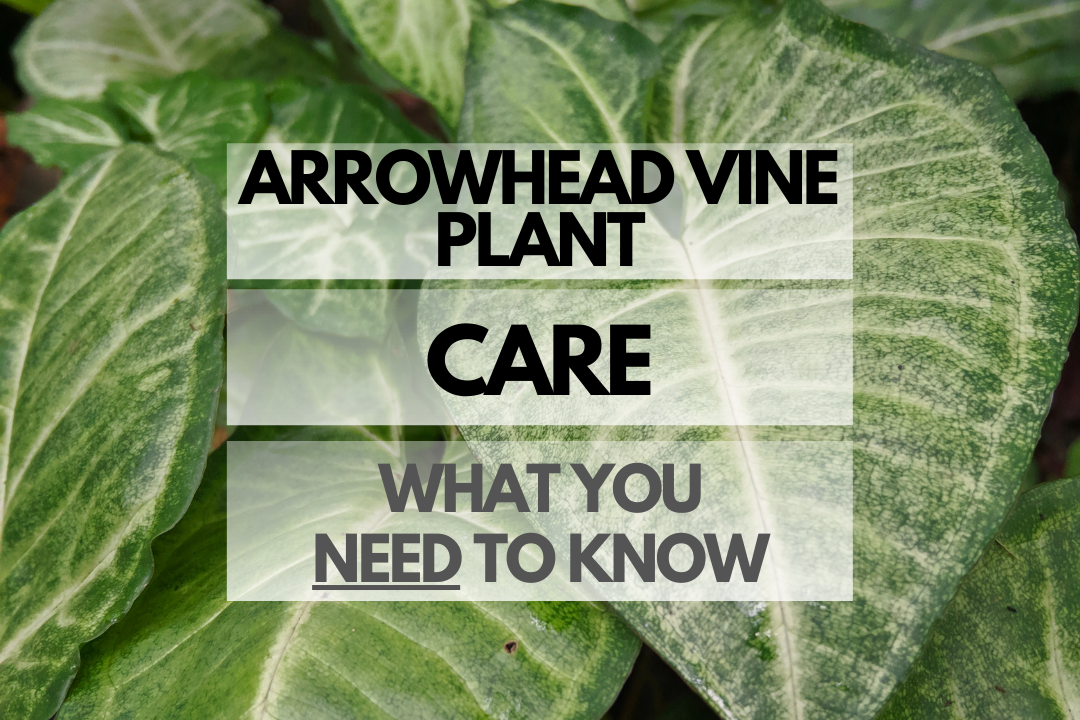If you’re looking for a versatile and easy-to-grow houseplant, the Arrowhead Vine Plant (Syngonium podophyllum) is a perfect choice. With its beautiful, arrow-shaped leaves and climbing or trailing growth habit, this plant adds a touch of tropical flair to any space. In this care guide, we’ll explore everything you need to know to keep your Arrowhead Vine Plant healthy and thriving.
Arrowhead Vine Plant Care Guide
Quick Reference Table: Caring for Arrowhead Vine Plant
| Aspect | Requirement |
|---|---|
| Sunlight | Bright, indirect light |
| Soil | Well-draining, rich potting mix |
| Watering | Keep soil consistently moist but not soggy |
| Pruning | Prune to maintain desired shape and size |
| Temperature | 60-85°F (16-29°C) |
| Common Problems | Pest infestations, root rot, leaf yellowing |
| Indoors/Outdoors | Can be grown both indoors and outdoors |
| Best Pots | Choose pots with drainage holes and a saucer to catch excess water |
Arrowhead Vine Plant Sunlight: Do They Need It and How Much?
Arrowhead Vine Plants thrive in bright, indirect light. Direct sunlight can scorch their leaves, while too little light can cause leggy growth and reduced leaf coloration. Place your plant near a north or east-facing window, or use a sheer curtain to diffuse the sunlight from a south or west-facing window.
Arrowhead Vine Plant Soil Tips
Arrowhead Vine Plants prefer a well-draining, rich potting mix that retains moisture without becoming waterlogged. A mix of peat moss, perlite, and potting soil in equal parts is ideal. To improve drainage, you can also add a layer of coarse material, such as gravel or coarse sand, at the bottom of the pot before adding the potting mix.
Arrowhead Vine Plant Watering and Frequency
Water your Arrowhead Vine Plant regularly to keep the soil consistently moist but not soggy. Allow the top inch of soil to dry out slightly between waterings, and reduce the frequency during the winter months. Over-watering can lead to root rot, while under-watering may cause the leaves to wilt and yellow.
Pruning Arrowhead Vine Plant Properly
Prune your Arrowhead Vine Plant as needed to maintain its desired shape and size. Regular pruning can also encourage bushier growth and prevent the plant from becoming too leggy. Use clean, sharp scissors or pruning shears to remove any dead, damaged, or overgrown stems and leaves.
Optimal Arrowhead Vine Plant Temperature: Can They Tolerate the Cold?
Arrowhead Vine Plants prefer warm temperatures between 60-85°F (16-29°C) and do not tolerate cold drafts or temperatures below 50°F (10°C). If you’re growing your plant outdoors, move it indoors when temperatures start to drop in the fall. Indoor plants should be kept away from cold drafts, such as those from air conditioning vents or windows.
Common Arrowhead Vine Plant Problems
Pest Infestations
Arrowhead Vine Plants are susceptible to common houseplant pests like spider mites, aphids, and mealybugs. Inspect your plant regularly for signs of infestation, such as webbing, sticky residue, or small insects. Treat any infestations with insecticidal soap or neem oil, and keep your plant clean by wiping the leaves with a damp cloth.
Root Rot
Over-watering your Arrowhead Vine Plant can lead to root rot, a fungal disease that causes the roots to turn brown, mushy, and decay. To prevent root rot, always allowthe top inch of soil to dry out between waterings and use a well-draining potting mix. If you suspect root rot, remove the affected roots, let the plant dry out, and repot it in fresh soil.
Leaf Yellowing
Yellow leaves can be a sign of over-watering, under-watering, or a lack of nutrients in the soil. To determine the cause, check the soil moisture and adjust your watering schedule accordingly. If the problem persists, consider repotting your plant with fresh potting mix or applying a balanced liquid fertilizer.
Arrowhead Vine Plant Outdoors vs Indoors
Arrowhead Vine Plants can be grown both indoors and outdoors. Below is a pros and cons list for both options:
| Location | Pros | Cons |
|---|---|---|
| Indoors |
|
|
| Outdoors |
|
|
Best Pots for Arrowhead Vine Plant
When selecting a pot for your Arrowhead Vine Plant, choose a container with drainage holes to prevent waterlogged soil. A saucer should be placed underneath the pot to catch excess water and protect surfaces from moisture damage. Both plastic and ceramic pots work well for this plant, but keep in mind that ceramic pots can be heavier and may require more frequent watering due to increased evaporation.
Arrowhead Vine Plant Facts
Arrowhead Vine Plant Benefits
Arrowhead Vine Plants offer several benefits, including:
- Air purification: These plants are known to remove indoor air pollutants, such as benzene, formaldehyde, and xylene, making them great additions to any living space.
- Low maintenance: Arrowhead Vine Plants are easy to care for and can tolerate a range of light and moisture conditions, making them perfect for novice and experienced gardeners alike.
- Versatility: With various leaf patterns and colors, Arrowhead Vine Plants can easily complement any interior design or outdoor landscape.
- Adaptable growth: These plants can be grown as climbing or trailing plants, making them suitable for hanging baskets, trellises, or tabletop displays.
Growth Rates: How Fast Do They Grow?
Arrowhead Vine Plants have a moderate growth rate, with some varieties growing faster than others. Under the right conditions, they can grow up to 3-6 feet in length per year. Providing the plant with proper care, including adequate light, water, and nutrients, will ensure optimal growth.
Arrowhead Vine Plant Lifespan
Arrowhead Vine Plants are perennial plants, meaning they can live for several years with proper care. Their lifespan can range from 5-10 years or more, depending on the specific variety and growing conditions.
Are Arrowhead Vine Plants Safe?
Arrowhead Vine Plants contain calcium oxalate crystals, which can cause skin irritation and digestive upset if ingested. While not considered highly toxic, they should be kept out of reach of children and pets to prevent accidental ingestion.
Arrowhead Vine Plant Flowers
Arrowhead Vine Plants can produce small, white or green flowers on a spadix, similar to those of other aroid plants. However, flowers are rare on indoor plants, as they typically require high humidity and specific conditions to bloom.
Arrowhead Vine Plant Types and Varieties
Syngonium podophyllum ‘White Butterfly’
This popular variety features green leaves with striking white veins, giving it a butterfly-like appearance. As the plant matures, the leaves develop a more elongated shape with distinct arrowhead-like lobes.
Syngonium podophyllum ‘Neon Robusta’
This variety is known for its vibrant neon-pink leaves that fade to a lighter shade as the plant ages. The leaves have a heart shape when young, becoming arrow-shaped as the plant matures.
Syngonium podophyllum ‘Maria Allusion’
Maria Allusion has striking dark green leaves with pink-red veins and a velvety texture. The leaves are arrow-shaped and become more pronounced as the plant grows.
Arrowhead Vine Plant Pros and Cons
| Pros | Cons |
|---|---|
|
|
Arrowhead Vine Plant Cost
The cost of an Arrowhead Vine Plant can vary depending on factors such as the plant size, variety, and the retailer. On average, a small plant can range from $5 to $15, while larger, more established plants can cost $25 or more.
Where to Buy Arrowhead Vine Plants
Arrowhead Vine Plants are widely available at local nurseries, garden centers, and online plant retailers. Some popular online sources include Etsy, Amazon, and specialized plant websites. Be sure to research the seller and read reviews to ensure you’re purchasing a healthy plant.
Is Arrowhead Vine Plant Propagation in Water Possible?
Yes, Arrowhead Vine Plant propagation in water is possible and relatively simple. To propagate, simply take stem cuttings with at least one leaf node and place them ina container of water. Change the water regularly and provide adequate light. Roots should begin to develop within a few weeks, after which you can transplant the cutting into soil.
Additional Resources
- Missouri Botanical Garden Plant Finder: Provides detailed information on Arrowhead Vine Plant care and growth requirements.
- Houseplant Hobbyist Facebook Group: A Facebook community where you can ask questions, share photos, and learn from fellow houseplant enthusiasts.
- r/houseplants on Reddit: A subreddit dedicated to the discussion of indoor gardening and plant care.
FAQ for Arrowhead Vine Plant Care
Are Arrowhead Vine Plants toxic to cats?
Yes, Arrowhead Vine Plants are toxic to cats. They contain calcium oxalate crystals, which can cause irritation and swelling in the mouth, throat, and gastrointestinal tract if ingested.
Are Arrowhead Vine Plants toxic to dogs?
Yes, Arrowhead Vine Plants are toxic to dogs for the same reasons as they are to cats. Keep the plant out of reach to prevent accidental ingestion.
Are Arrowhead Vine Plants toxic to kids?
While not considered highly toxic, Arrowhead Vine Plants can cause irritation and digestive upset if ingested by children. It’s best to keep these plants out of reach of young children.
How tall do Arrowhead Vine Plants get?
Arrowhead Vine Plants can grow up to 6 feet in length or more, depending on the specific variety and growing conditions. Regular pruning can help maintain a more compact size if desired.
Can Arrowhead Vine Plants live outside?
Arrowhead Vine Plants can be grown outdoors in USDA hardiness zones 10-12. They prefer a location with bright, indirect light and well-draining soil. In cooler climates, they can be grown outdoors during the warmer months and brought indoors before the first frost.
Are Arrowhead Vine Plants poisonous?
Arrowhead Vine Plants contain calcium oxalate crystals, which can cause skin irritation and digestive upset if ingested. While not considered highly toxic, it’s best to keep these plants out of reach of children and pets.

